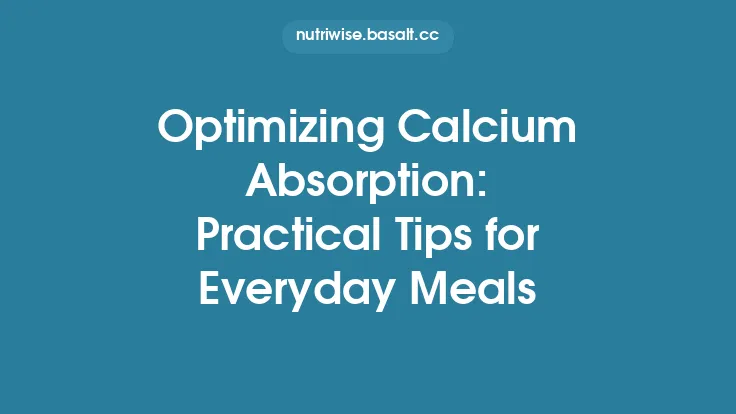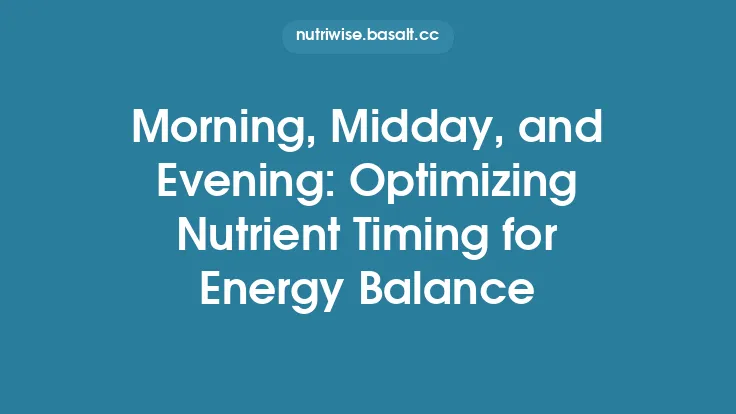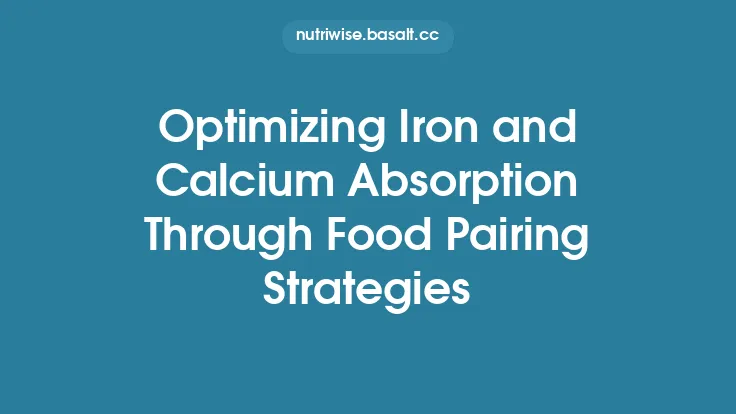Micronutrients are the tiny powerhouses that keep every cellular process humming, yet their effectiveness hinges not only on how much we consume but also on *when and with what* we eat them. While the sheer presence of vitamins and minerals in a diet is essential, the timing of intake and the strategic pairing of foods can dramatically influence how much of these nutrients actually cross the intestinal barrier and become available for use. Below, we explore the science behind temporal dynamics and food‑pairing strategies that can be woven into everyday meals, helping you extract the maximum benefit from every bite.
The Chronobiology of Micronutrient Metabolism
Human physiology follows a roughly 24‑hour circadian rhythm, orchestrated by the suprachiasmatic nucleus in the brain. This internal clock regulates hormone secretion, enzyme activity, and transporter expression in the gut and liver—processes that directly affect micronutrient handling.
| Micronutrient | Peak Absorptive Window | Key Circadian Drivers |
|---|---|---|
| Vitamin D | Early afternoon (12–15 h) | Sun‑induced skin synthesis, hepatic 25‑hydroxylase activity |
| Calcium | Evening (18–22 h) | Parathyroid hormone (PTH) surge, nocturnal bone remodeling |
| Iron | Morning (6–10 h) | Higher gastric acidity, lower hepcidin levels |
| B‑vitamins | Mid‑morning (8–11 h) | Peak hepatic uptake enzymes, active glycolysis |
| Magnesium | Late night (22–2 h) | Restorative cellular repair, melatonin‑mediated transport |
These patterns arise because transport proteins (e.g., DMT1 for iron, NPC1L1 for cholesterol‑linked vitamins) and binding carriers (e.g., transcobalamin for B12) are expressed rhythmically. Aligning nutrient intake with these peaks can improve fractional absorption by 10–30 % compared with random timing.
Strategic Meal Sequencing for Optimal Uptake
The order in which foods appear on the plate can create micro‑environments that favor or hinder micronutrient transport. A simple “front‑to‑back” sequencing model can be applied:
- Start with a low‑fiber, low‑phytate starter – a small bowl of broth or a citrus‑based salad dressing. This primes gastric acidity and reduces early binding of minerals.
- Introduce protein‑rich components – lean meats, legumes, or dairy. Proteins stimulate gastric secretions and provide amino acids that act as chelators for minerals like zinc and copper.
- Add fat‑laden foods – avocado, nuts, or a drizzle of olive oil. The presence of dietary lipids triggers bile release, essential for emulsifying fat‑soluble vitamins (A, D, E, K).
- Finish with high‑fiber, phytate‑rich vegetables – leafy greens, cruciferous sprouts. By this stage, the gut lumen is already primed for nutrient uptake, and the slower‑digesting fiber does not compete as aggressively for transporters.
Research using stable isotope tracers shows that this sequencing can raise the apparent absorption of iron by ~15 % and vitamin A by ~20 % compared with a mixed‑order meal.
Fat‑Soluble Vitamin Pairing: Timing with Dietary Lipids
Fat‑soluble vitamins require micelle formation for intestinal uptake. The efficiency of this process is dictated by the type, quantity, and timing of dietary fat.
- Quantity: Approximately 5–7 g of total fat per meal is sufficient to maximize micelle formation for vitamins A, D, E, and K. Adding more fat beyond this threshold yields diminishing returns.
- Type: Long‑chain triglycerides (LCTs) from animal fats or tropical oils (e.g., coconut) promote larger micelles, while medium‑chain triglycerides (MCTs) are rapidly oxidized and contribute less to micelle stability. A balanced mix (≈60 % LCT, 40 % MCT) offers optimal absorption without excessive caloric load.
- Timing: Consuming the fat source within 30 minutes of the vitamin‑rich food ensures that bile salts and pancreatic lipase are present when the vitamin is released from the food matrix. For example, pairing a spinach salad (vitamin K) with a vinaigrette containing 1 tbsp olive oil right before the main course maximizes K uptake.
Enhancing Mineral Absorption Through Temporal Synergy
Minerals often compete for shared transport pathways. By staggering their intake across the day, you can reduce competitive inhibition.
| Mineral | Preferred Timing | Rationale |
|---|---|---|
| Iron | Breakfast (6–10 h) | Low hepcidin, high gastric acidity |
| Zinc | Mid‑day (11–14 h) | Peak metallothionein expression |
| Calcium | Evening (18–22 h) | Elevated PTH, bone remodeling phase |
| Magnesium | Late night (22–2 h) | Supports nocturnal ATP synthesis |
A practical illustration: a fortified oatmeal breakfast supplies iron and B‑vitamins, a quinoa‑based lunch delivers zinc and B‑complex, while a dairy‑rich dinner supplies calcium and magnesium. This temporal distribution minimizes transporter competition and aligns with hormonal cycles that regulate mineral handling.
Vitamin–Mineral Interactions: Pairing for Mutual Benefit
Certain vitamins act as *co‑factors* that facilitate mineral transport, while some minerals stabilize vitamin structures. Understanding these pairings allows you to design meals where the presence of one nutrient actively enhances the absorption of another.
- Vitamin C + Non‑heme Iron: Ascorbic acid reduces ferric (Fe³⁺) to ferrous (Fe²⁺) form, which is the substrate for DMT1. Pair citrus fruit or bell peppers with plant‑based iron sources (lentils, spinach) at the same meal.
- Vitamin D + Calcium: Vitamin D up‑regulates intestinal calcium channels (TRPV6). Consuming vitamin D‑rich foods (fatty fish, fortified eggs) alongside calcium sources (dairy, fortified tofu) within the same 2‑hour window synergistically boosts calcium absorption.
- Vitamin K2 + Calcium: K2 activates osteocalcin, directing calcium to bone rather than soft tissue. Pair fermented foods (natto, kefir) with calcium‑rich meals to support skeletal deposition.
- Vitamin B12 + Folate: Both are required for the methylation cycle; adequate folate ensures B12 is efficiently utilized in DNA synthesis. Include leafy greens (folate) with animal proteins (B12) in the same meal.
When designing a plate, aim for at least one such synergistic pair per main meal to harness these biochemical collaborations.
Timing of Supplementation Relative to Meals
Supplement forms (tablet, capsule, powder) differ in dissolution rates, and their interaction with food can either enhance or impede absorption.
| Supplement Form | Ideal Timing | Key Considerations |
|---|---|---|
| Water‑soluble vitamins (C, B‑complex) | 30 min before or 2 h after meals | Empty‑stomach environment avoids competition with dietary amino acids |
| Fat‑soluble vitamins (A, D, E, K) | With a meal containing ≥5 g fat | Bile secretion is essential for micelle formation |
| Iron tablets (ferrous sulfate) | 30 min before breakfast, with a source of vitamin C | Avoid calcium‑rich foods within 2 h to prevent inhibition |
| Calcium citrate | With dinner or before bedtime | Works best in a mildly acidic environment; does not require stomach acid |
| Magnesium glycinate | Before sleep | Supports nocturnal muscle relaxation and ATP production |
| Multivitamin/mineral complexes | With a balanced lunch (protein + fat + carbs) | Provides a middle ground for both water‑ and fat‑soluble components |
A common pitfall is taking a broad‑spectrum multivitamin on an empty stomach, which can cause nausea and reduce absorption of fat‑soluble vitamins. Aligning the supplement with a modestly sized, balanced meal mitigates these issues.
Exercise, Recovery, and Micronutrient Timing
Physical activity creates transient windows of heightened nutrient demand:
- Post‑exercise (30–60 min): Muscle cells become more permeable to glucose, amino acids, and certain minerals (magnesium, potassium). This period also sees an up‑regulation of transporters for vitamin C and B‑vitamins, supporting oxidative stress mitigation and energy metabolism.
- During endurance events: Small, frequent intakes of electrolytes (sodium, potassium, magnesium) and B‑vitamins help sustain neuromuscular function.
- Strength training: A post‑workout meal containing protein, a modest amount of fat, and vitamin D can accelerate muscle protein synthesis and bone remodeling.
Practical example: after a 45‑minute resistance session, consume a smoothie with whey protein, a handful of berries (vitamin C), a splash of fortified almond milk (vitamin D and calcium), and a pinch of sea salt (sodium). This combination leverages the post‑exercise absorption window for both macronutrients and micronutrients.
Practical Meal‑Planning Templates
Below are three day‑long templates that embed timing and pairing principles without requiring exotic ingredients. Adjust portion sizes to meet individual caloric needs.
Template A – “Morning Iron Boost”
- 06:30 h – Pre‑breakfast: 250 ml orange juice (vitamin C) + 1 tablet iron supplement (ferrous gluconate)
- 07:30 h – Breakfast: Steel‑cut oats cooked in water, topped with sliced strawberries, a tablespoon of ground flaxseed, and a dollop of Greek yogurt (calcium, protein)
- 12:00 h – Lunch: Quinoa salad with chickpeas, roasted red peppers, spinach, and a lemon‑olive‑oil dressing (fat for vitamins A/E/K)
- 15:30 h – Snack: Handful of almonds (magnesium, healthy fats) + a small apple
- 18:30 h – Dinner: Baked salmon (vitamin D, omega‑3), steamed broccoli (vitamin K, calcium), and a side of sweet potato (beta‑carotene)
- 22:00 h – Pre‑bed: Warm milk (calcium) with a pinch of magnesium glycinate powder
Template B – “Evening Calcium & Magnesium”
- 08:00 h – Breakfast: Whole‑grain toast with avocado (fat) and poached egg (vitamin D)
- 11:30 h – Mid‑morning snack: Yogurt parfait with mixed berries (vitamin C) and a drizzle of honey
- 13:00 h – Lunch: Lentil soup (iron, zinc) with a side of kale salad dressed in sesame oil (fat, calcium)
- 16:30 h – Snack: Cottage cheese (calcium) with pineapple chunks (vitamin C)
- 19:00 h – Dinner: Grilled chicken thigh, roasted Brussels sprouts (vitamin K), and quinoa pilaf (magnesium)
- 21:30 h – Bedtime: Chamomile tea + 200 mg magnesium citrate capsule
Template C – “Post‑Workout Micronutrient Surge”
- 07:00 h – Light pre‑run snack: Banana (potassium) + 200 mg vitamin C tablet
- 08:30 h – Post‑run recovery shake: Whey protein, frozen mixed berries, fortified soy milk (vitamin D, calcium), and a pinch of sea salt
- 12:30 h – Lunch: Turkey wrap with whole‑grain tortilla, mixed greens, shredded carrots, and hummus (iron, zinc)
- 15:00 h – Snack: Dark chocolate square (magnesium) + orange slices (vitamin C)
- 18:30 h – Dinner: Stir‑fried tofu (calcium set) with bell peppers, snap peas, and a tablespoon of coconut oil (fat for vitamin E)
- 22:00 h – Nightcap: Warm almond milk (magnesium, calcium) with a dash of cinnamon
These templates illustrate how timing, food pairing, and macronutrient balance can be orchestrated to create consistent absorption “peaks” for a broad spectrum of micronutrients.
Putting It All Together
Optimizing micronutrient absorption is less about isolated foods and more about the temporal choreography of meals. By aligning intake with circadian rhythms, sequencing dishes to prime the gut environment, pairing fat‑soluble vitamins with appropriate lipids, and spacing minerals to avoid transporter competition, you can unlock a measurable boost in bioavailability. Incorporating these strategies into daily planning—whether through structured meal templates or mindful supplement timing—transforms a standard diet into a finely tuned nutrient delivery system, supporting health, performance, and long‑term vitality.





